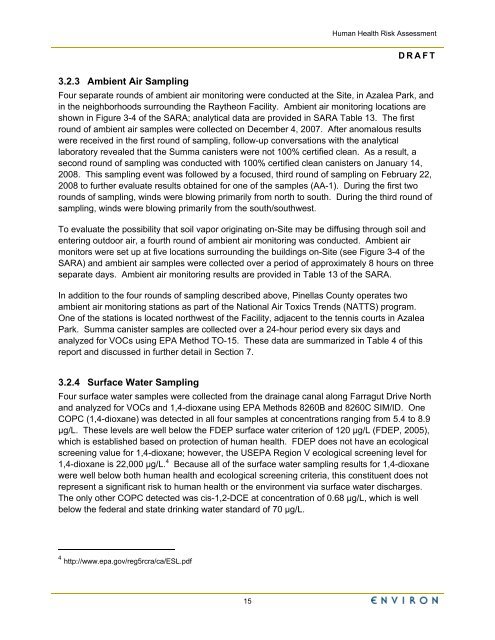Human Health Risk Assessment - Raytheon
Human Health Risk Assessment - Raytheon
Human Health Risk Assessment - Raytheon
You also want an ePaper? Increase the reach of your titles
YUMPU automatically turns print PDFs into web optimized ePapers that Google loves.
3.2.3 Ambient Air Sampling<br />
15<br />
<strong>Human</strong> <strong>Health</strong> <strong>Risk</strong> <strong>Assessment</strong><br />
DRAFT<br />
Four separate rounds of ambient air monitoring were conducted at the Site, in Azalea Park, and<br />
in the neighborhoods surrounding the <strong>Raytheon</strong> Facility. Ambient air monitoring locations are<br />
shown in Figure 3-4 of the SARA; analytical data are provided in SARA Table 13. The first<br />
round of ambient air samples were collected on December 4, 2007. After anomalous results<br />
were received in the first round of sampling, follow-up conversations with the analytical<br />
laboratory revealed that the Summa canisters were not 100% certified clean. As a result, a<br />
second round of sampling was conducted with 100% certified clean canisters on January 14,<br />
2008. This sampling event was followed by a focused, third round of sampling on February 22,<br />
2008 to further evaluate results obtained for one of the samples (AA-1). During the first two<br />
rounds of sampling, winds were blowing primarily from north to south. During the third round of<br />
sampling, winds were blowing primarily from the south/southwest.<br />
To evaluate the possibility that soil vapor originating on-Site may be diffusing through soil and<br />
entering outdoor air, a fourth round of ambient air monitoring was conducted. Ambient air<br />
monitors were set up at five locations surrounding the buildings on-Site (see Figure 3-4 of the<br />
SARA) and ambient air samples were collected over a period of approximately 8 hours on three<br />
separate days. Ambient air monitoring results are provided in Table 13 of the SARA.<br />
In addition to the four rounds of sampling described above, Pinellas County operates two<br />
ambient air monitoring stations as part of the National Air Toxics Trends (NATTS) program.<br />
One of the stations is located northwest of the Facility, adjacent to the tennis courts in Azalea<br />
Park. Summa canister samples are collected over a 24-hour period every six days and<br />
analyzed for VOCs using EPA Method TO-15. These data are summarized in Table 4 of this<br />
report and discussed in further detail in Section 7.<br />
3.2.4 Surface Water Sampling<br />
Four surface water samples were collected from the drainage canal along Farragut Drive North<br />
and analyzed for VOCs and 1,4-dioxane using EPA Methods 8260B and 8260C SIM/ID. One<br />
COPC (1,4-dioxane) was detected in all four samples at concentrations ranging from 5.4 to 8.9<br />
µg/L. These levels are well below the FDEP surface water criterion of 120 µg/L (FDEP, 2005),<br />
which is established based on protection of human health. FDEP does not have an ecological<br />
screening value for 1,4-dioxane; however, the USEPA Region V ecological screening level for<br />
1,4-dioxane is 22,000 µg/L. 4 Because all of the surface water sampling results for 1,4-dioxane<br />
were well below both human health and ecological screening criteria, this constituent does not<br />
represent a significant risk to human health or the environment via surface water discharges.<br />
The only other COPC detected was cis-1,2-DCE at concentration of 0.68 µg/L, which is well<br />
below the federal and state drinking water standard of 70 µg/L.<br />
4 http://www.epa.gov/reg5rcra/ca/ESL.pdf

















